Enterprise Transformation and Innovation: Success and Failure Factors
VerifiedAdded on 2022/11/23
|9
|1991
|26
Report
AI Summary
This report provides a detailed analysis of enterprise transformation and innovation, examining the factors that contribute to both success and failure within organizations. It explores the concept of enterprise transformation as a fundamental shift in how a business operates, considering market changes and operational improvements. The report delves into the reasons behind transformation failures, including clashes with organizational culture, lack of executive support, and resistance to change. It contrasts successful and unsuccessful firms, highlighting the importance of business structure, employee management, and innovative competitive strategies. The report also identifies key issues such as the high costs of innovation, the need for strong leadership, and the availability of resources. Recommendations include developing a comprehensive enterprise management strategy, conducting risk analysis, and establishing effective feedback mechanisms. The report concludes by emphasizing the critical role of enterprise project management in achieving successful organizational change and the importance of addressing financial and digital aspects with expert guidance. References include academic research on enterprise transformation, business strategy, and change management.
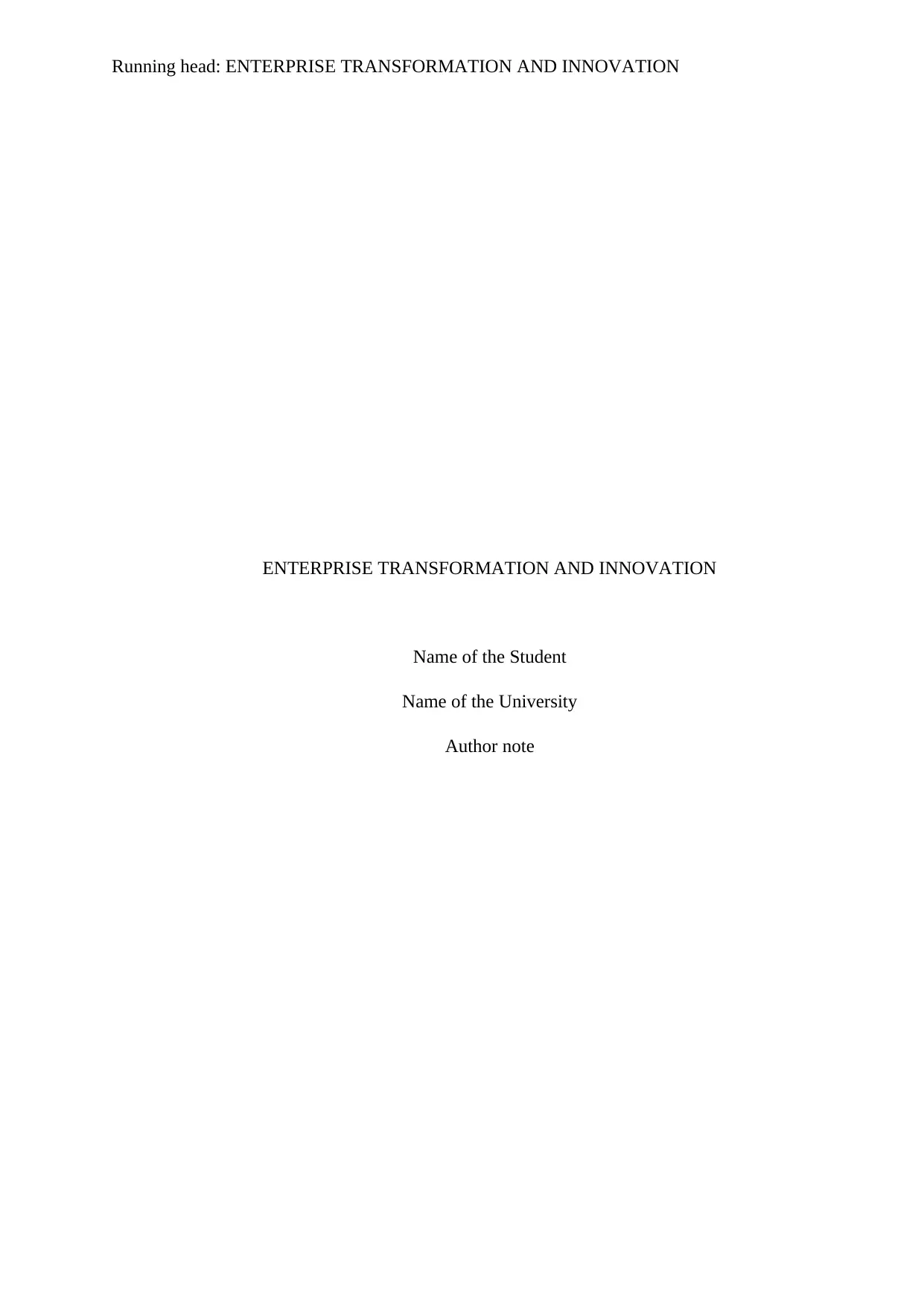
Running head: ENTERPRISE TRANSFORMATION AND INNOVATION
ENTERPRISE TRANSFORMATION AND INNOVATION
Name of the Student
Name of the University
Author note
ENTERPRISE TRANSFORMATION AND INNOVATION
Name of the Student
Name of the University
Author note
Paraphrase This Document
Need a fresh take? Get an instant paraphrase of this document with our AI Paraphraser
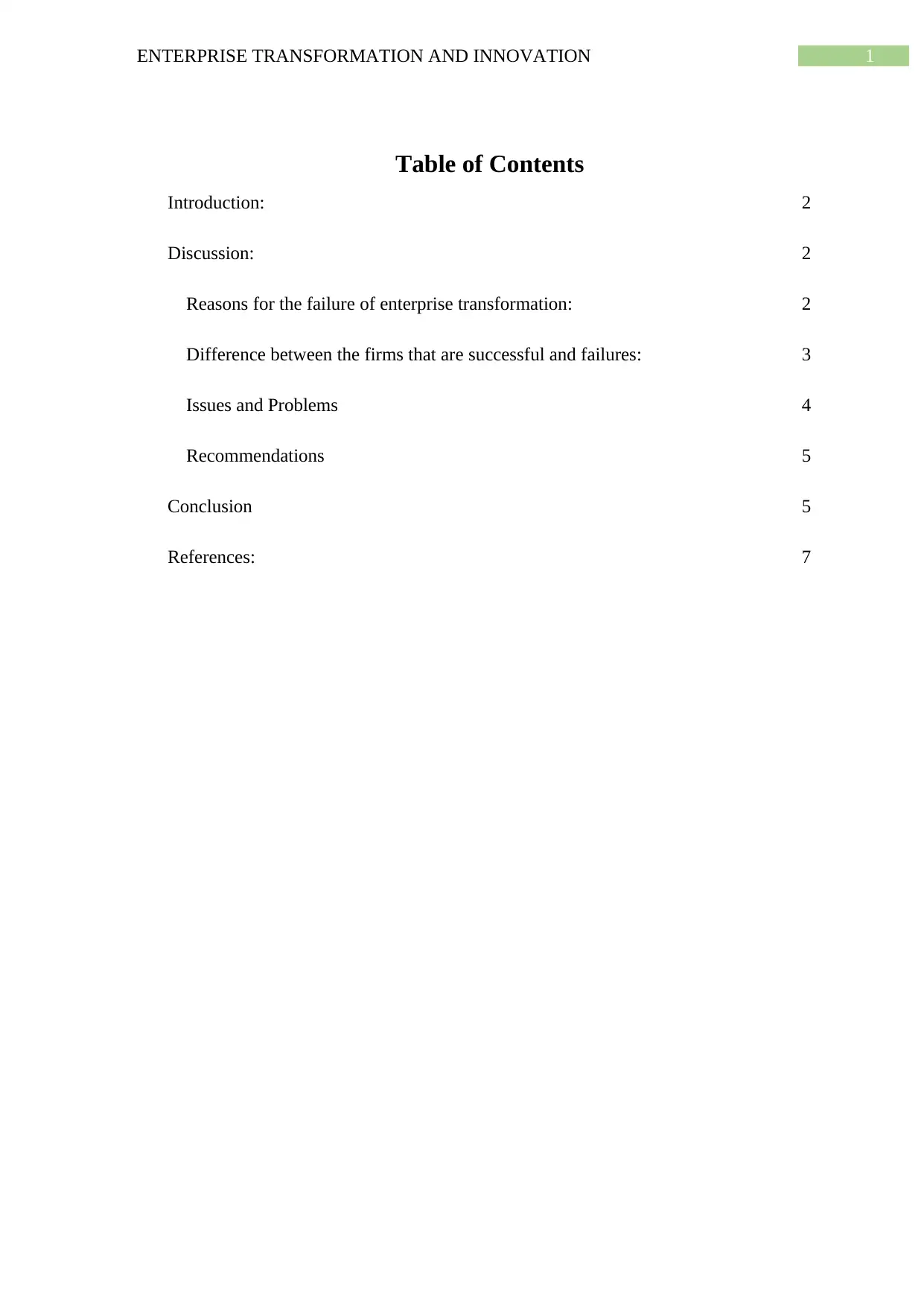
1ENTERPRISE TRANSFORMATION AND INNOVATION
Table of Contents
Introduction: 2
Discussion: 2
Reasons for the failure of enterprise transformation: 2
Difference between the firms that are successful and failures: 3
Issues and Problems 4
Recommendations 5
Conclusion 5
References: 7
Table of Contents
Introduction: 2
Discussion: 2
Reasons for the failure of enterprise transformation: 2
Difference between the firms that are successful and failures: 3
Issues and Problems 4
Recommendations 5
Conclusion 5
References: 7
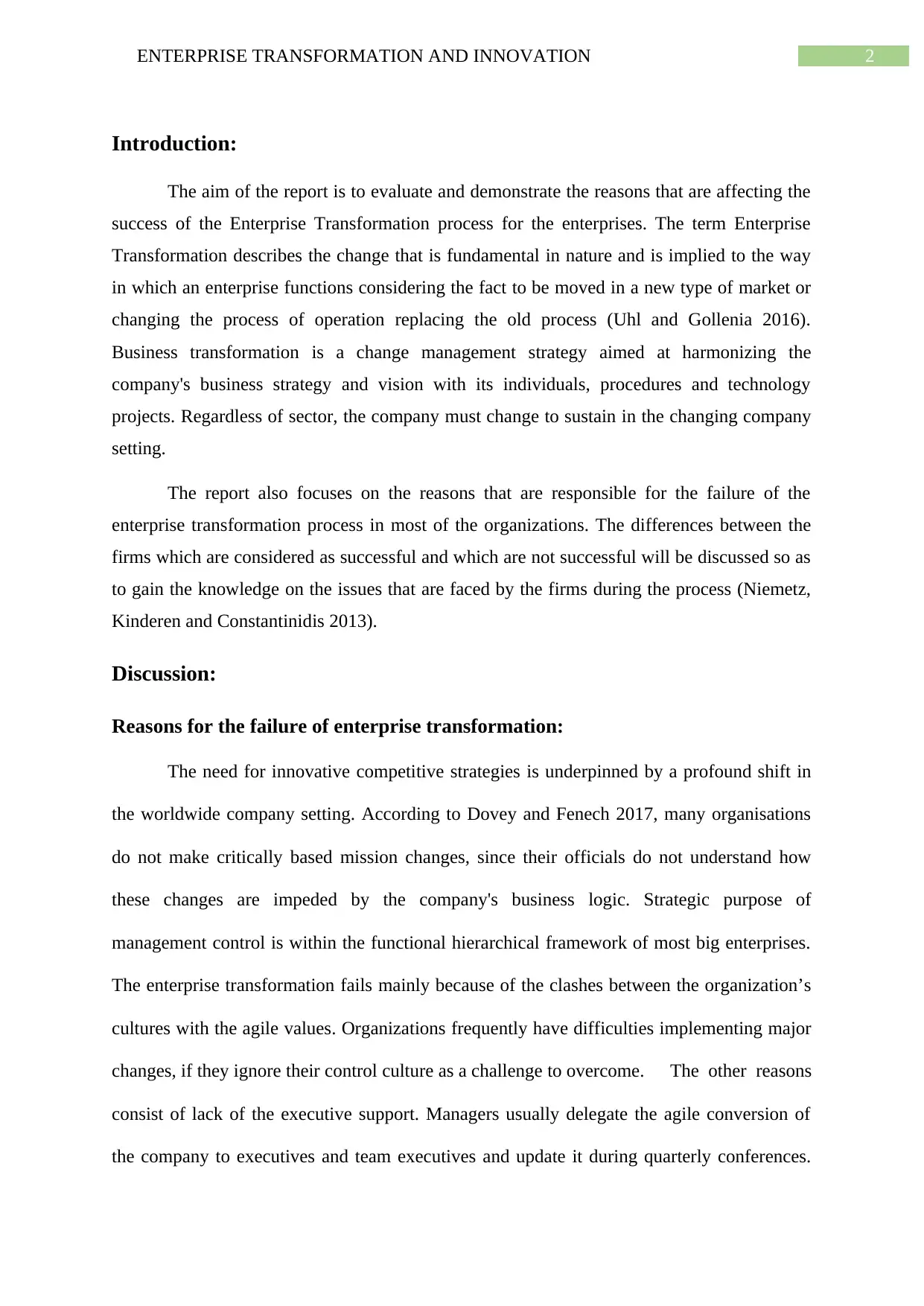
2ENTERPRISE TRANSFORMATION AND INNOVATION
Introduction:
The aim of the report is to evaluate and demonstrate the reasons that are affecting the
success of the Enterprise Transformation process for the enterprises. The term Enterprise
Transformation describes the change that is fundamental in nature and is implied to the way
in which an enterprise functions considering the fact to be moved in a new type of market or
changing the process of operation replacing the old process (Uhl and Gollenia 2016).
Business transformation is a change management strategy aimed at harmonizing the
company's business strategy and vision with its individuals, procedures and technology
projects. Regardless of sector, the company must change to sustain in the changing company
setting.
The report also focuses on the reasons that are responsible for the failure of the
enterprise transformation process in most of the organizations. The differences between the
firms which are considered as successful and which are not successful will be discussed so as
to gain the knowledge on the issues that are faced by the firms during the process (Niemetz,
Kinderen and Constantinidis 2013).
Discussion:
Reasons for the failure of enterprise transformation:
The need for innovative competitive strategies is underpinned by a profound shift in
the worldwide company setting. According to Dovey and Fenech 2017, many organisations
do not make critically based mission changes, since their officials do not understand how
these changes are impeded by the company's business logic. Strategic purpose of
management control is within the functional hierarchical framework of most big enterprises.
The enterprise transformation fails mainly because of the clashes between the organization’s
cultures with the agile values. Organizations frequently have difficulties implementing major
changes, if they ignore their control culture as a challenge to overcome. The other reasons
consist of lack of the executive support. Managers usually delegate the agile conversion of
the company to executives and team executives and update it during quarterly conferences.
Introduction:
The aim of the report is to evaluate and demonstrate the reasons that are affecting the
success of the Enterprise Transformation process for the enterprises. The term Enterprise
Transformation describes the change that is fundamental in nature and is implied to the way
in which an enterprise functions considering the fact to be moved in a new type of market or
changing the process of operation replacing the old process (Uhl and Gollenia 2016).
Business transformation is a change management strategy aimed at harmonizing the
company's business strategy and vision with its individuals, procedures and technology
projects. Regardless of sector, the company must change to sustain in the changing company
setting.
The report also focuses on the reasons that are responsible for the failure of the
enterprise transformation process in most of the organizations. The differences between the
firms which are considered as successful and which are not successful will be discussed so as
to gain the knowledge on the issues that are faced by the firms during the process (Niemetz,
Kinderen and Constantinidis 2013).
Discussion:
Reasons for the failure of enterprise transformation:
The need for innovative competitive strategies is underpinned by a profound shift in
the worldwide company setting. According to Dovey and Fenech 2017, many organisations
do not make critically based mission changes, since their officials do not understand how
these changes are impeded by the company's business logic. Strategic purpose of
management control is within the functional hierarchical framework of most big enterprises.
The enterprise transformation fails mainly because of the clashes between the organization’s
cultures with the agile values. Organizations frequently have difficulties implementing major
changes, if they ignore their control culture as a challenge to overcome. The other reasons
consist of lack of the executive support. Managers usually delegate the agile conversion of
the company to executives and team executives and update it during quarterly conferences.
⊘ This is a preview!⊘
Do you want full access?
Subscribe today to unlock all pages.

Trusted by 1+ million students worldwide
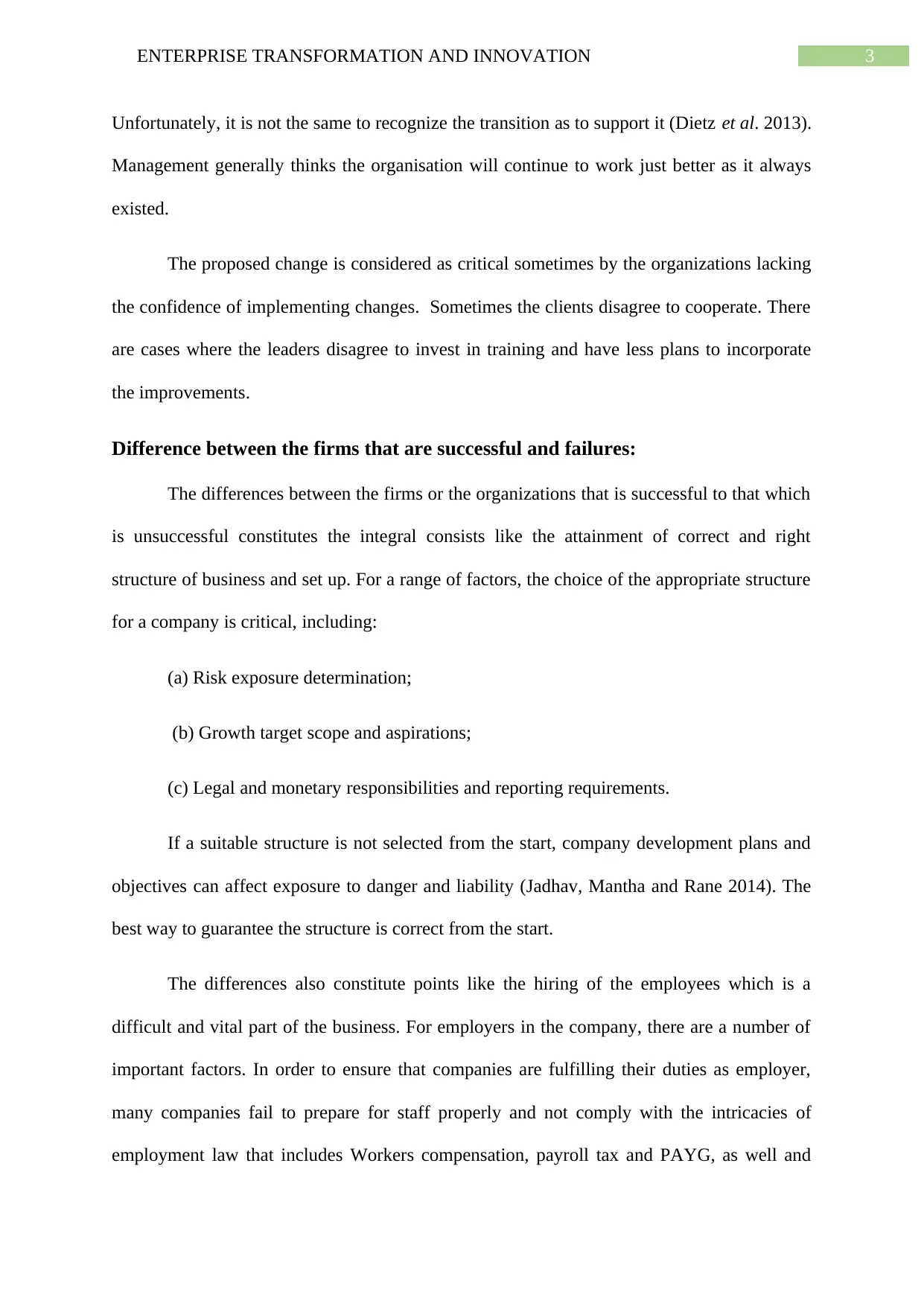
3ENTERPRISE TRANSFORMATION AND INNOVATION
Unfortunately, it is not the same to recognize the transition as to support it (Dietz et al. 2013).
Management generally thinks the organisation will continue to work just better as it always
existed.
The proposed change is considered as critical sometimes by the organizations lacking
the confidence of implementing changes. Sometimes the clients disagree to cooperate. There
are cases where the leaders disagree to invest in training and have less plans to incorporate
the improvements.
Difference between the firms that are successful and failures:
The differences between the firms or the organizations that is successful to that which
is unsuccessful constitutes the integral consists like the attainment of correct and right
structure of business and set up. For a range of factors, the choice of the appropriate structure
for a company is critical, including:
(a) Risk exposure determination;
(b) Growth target scope and aspirations;
(c) Legal and monetary responsibilities and reporting requirements.
If a suitable structure is not selected from the start, company development plans and
objectives can affect exposure to danger and liability (Jadhav, Mantha and Rane 2014). The
best way to guarantee the structure is correct from the start.
The differences also constitute points like the hiring of the employees which is a
difficult and vital part of the business. For employers in the company, there are a number of
important factors. In order to ensure that companies are fulfilling their duties as employer,
many companies fail to prepare for staff properly and not comply with the intricacies of
employment law that includes Workers compensation, payroll tax and PAYG, as well and
Unfortunately, it is not the same to recognize the transition as to support it (Dietz et al. 2013).
Management generally thinks the organisation will continue to work just better as it always
existed.
The proposed change is considered as critical sometimes by the organizations lacking
the confidence of implementing changes. Sometimes the clients disagree to cooperate. There
are cases where the leaders disagree to invest in training and have less plans to incorporate
the improvements.
Difference between the firms that are successful and failures:
The differences between the firms or the organizations that is successful to that which
is unsuccessful constitutes the integral consists like the attainment of correct and right
structure of business and set up. For a range of factors, the choice of the appropriate structure
for a company is critical, including:
(a) Risk exposure determination;
(b) Growth target scope and aspirations;
(c) Legal and monetary responsibilities and reporting requirements.
If a suitable structure is not selected from the start, company development plans and
objectives can affect exposure to danger and liability (Jadhav, Mantha and Rane 2014). The
best way to guarantee the structure is correct from the start.
The differences also constitute points like the hiring of the employees which is a
difficult and vital part of the business. For employers in the company, there are a number of
important factors. In order to ensure that companies are fulfilling their duties as employer,
many companies fail to prepare for staff properly and not comply with the intricacies of
employment law that includes Workers compensation, payroll tax and PAYG, as well and
Paraphrase This Document
Need a fresh take? Get an instant paraphrase of this document with our AI Paraphraser
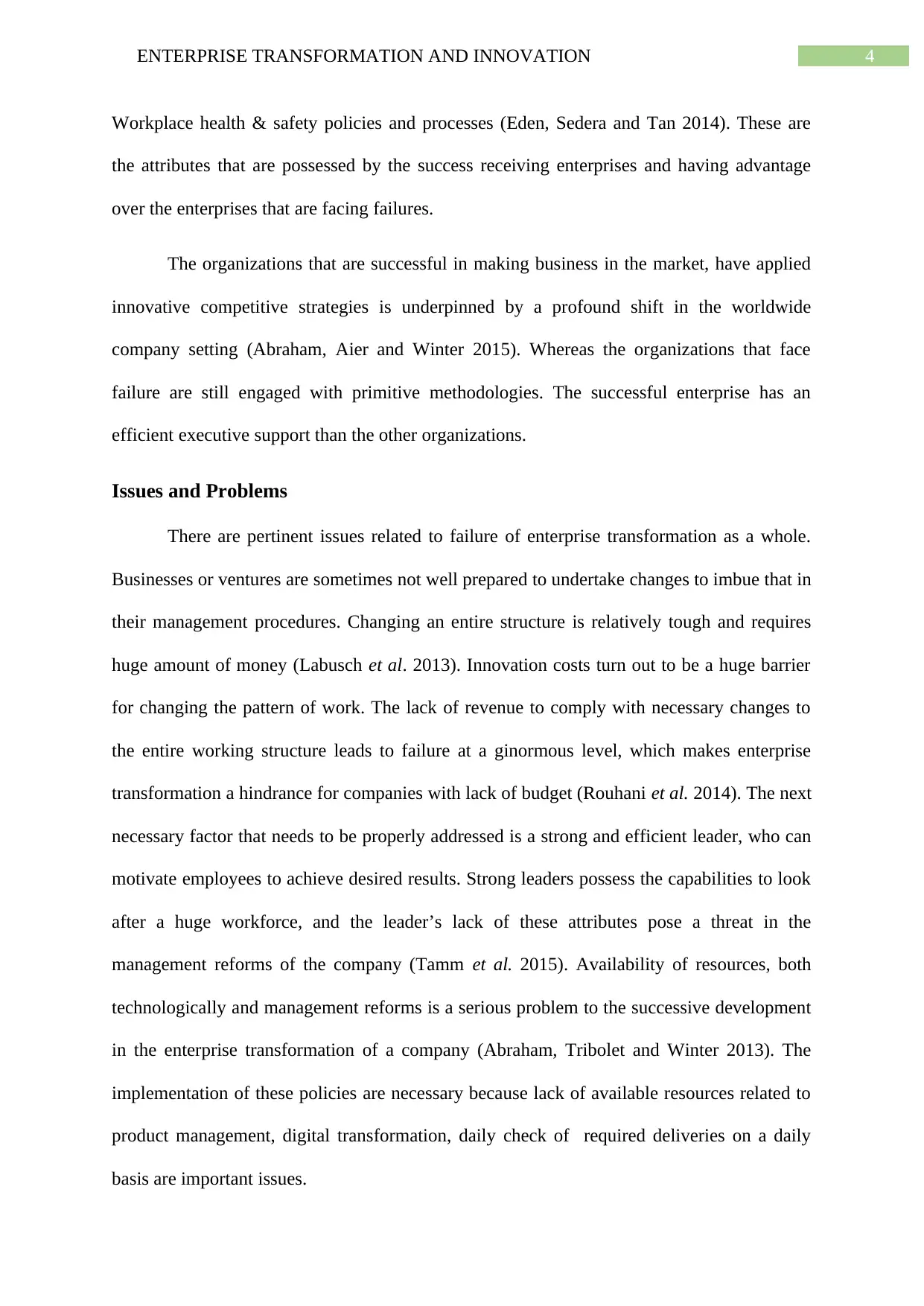
4ENTERPRISE TRANSFORMATION AND INNOVATION
Workplace health & safety policies and processes (Eden, Sedera and Tan 2014). These are
the attributes that are possessed by the success receiving enterprises and having advantage
over the enterprises that are facing failures.
The organizations that are successful in making business in the market, have applied
innovative competitive strategies is underpinned by a profound shift in the worldwide
company setting (Abraham, Aier and Winter 2015). Whereas the organizations that face
failure are still engaged with primitive methodologies. The successful enterprise has an
efficient executive support than the other organizations.
Issues and Problems
There are pertinent issues related to failure of enterprise transformation as a whole.
Businesses or ventures are sometimes not well prepared to undertake changes to imbue that in
their management procedures. Changing an entire structure is relatively tough and requires
huge amount of money (Labusch et al. 2013). Innovation costs turn out to be a huge barrier
for changing the pattern of work. The lack of revenue to comply with necessary changes to
the entire working structure leads to failure at a ginormous level, which makes enterprise
transformation a hindrance for companies with lack of budget (Rouhani et al. 2014). The next
necessary factor that needs to be properly addressed is a strong and efficient leader, who can
motivate employees to achieve desired results. Strong leaders possess the capabilities to look
after a huge workforce, and the leader’s lack of these attributes pose a threat in the
management reforms of the company (Tamm et al. 2015). Availability of resources, both
technologically and management reforms is a serious problem to the successive development
in the enterprise transformation of a company (Abraham, Tribolet and Winter 2013). The
implementation of these policies are necessary because lack of available resources related to
product management, digital transformation, daily check of required deliveries on a daily
basis are important issues.
Workplace health & safety policies and processes (Eden, Sedera and Tan 2014). These are
the attributes that are possessed by the success receiving enterprises and having advantage
over the enterprises that are facing failures.
The organizations that are successful in making business in the market, have applied
innovative competitive strategies is underpinned by a profound shift in the worldwide
company setting (Abraham, Aier and Winter 2015). Whereas the organizations that face
failure are still engaged with primitive methodologies. The successful enterprise has an
efficient executive support than the other organizations.
Issues and Problems
There are pertinent issues related to failure of enterprise transformation as a whole.
Businesses or ventures are sometimes not well prepared to undertake changes to imbue that in
their management procedures. Changing an entire structure is relatively tough and requires
huge amount of money (Labusch et al. 2013). Innovation costs turn out to be a huge barrier
for changing the pattern of work. The lack of revenue to comply with necessary changes to
the entire working structure leads to failure at a ginormous level, which makes enterprise
transformation a hindrance for companies with lack of budget (Rouhani et al. 2014). The next
necessary factor that needs to be properly addressed is a strong and efficient leader, who can
motivate employees to achieve desired results. Strong leaders possess the capabilities to look
after a huge workforce, and the leader’s lack of these attributes pose a threat in the
management reforms of the company (Tamm et al. 2015). Availability of resources, both
technologically and management reforms is a serious problem to the successive development
in the enterprise transformation of a company (Abraham, Tribolet and Winter 2013). The
implementation of these policies are necessary because lack of available resources related to
product management, digital transformation, daily check of required deliveries on a daily
basis are important issues.
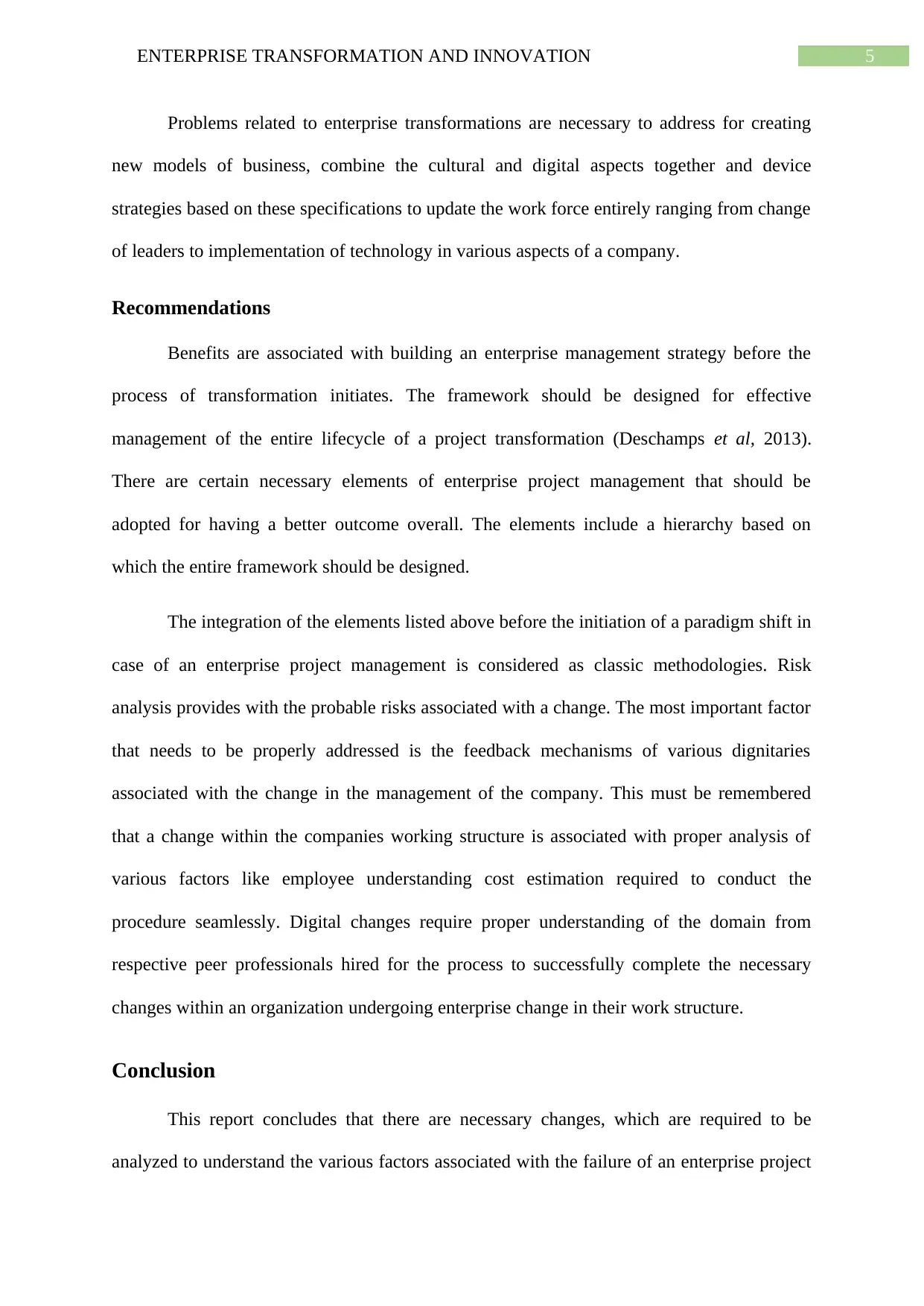
5ENTERPRISE TRANSFORMATION AND INNOVATION
Problems related to enterprise transformations are necessary to address for creating
new models of business, combine the cultural and digital aspects together and device
strategies based on these specifications to update the work force entirely ranging from change
of leaders to implementation of technology in various aspects of a company.
Recommendations
Benefits are associated with building an enterprise management strategy before the
process of transformation initiates. The framework should be designed for effective
management of the entire lifecycle of a project transformation (Deschamps et al, 2013).
There are certain necessary elements of enterprise project management that should be
adopted for having a better outcome overall. The elements include a hierarchy based on
which the entire framework should be designed.
The integration of the elements listed above before the initiation of a paradigm shift in
case of an enterprise project management is considered as classic methodologies. Risk
analysis provides with the probable risks associated with a change. The most important factor
that needs to be properly addressed is the feedback mechanisms of various dignitaries
associated with the change in the management of the company. This must be remembered
that a change within the companies working structure is associated with proper analysis of
various factors like employee understanding cost estimation required to conduct the
procedure seamlessly. Digital changes require proper understanding of the domain from
respective peer professionals hired for the process to successfully complete the necessary
changes within an organization undergoing enterprise change in their work structure.
Conclusion
This report concludes that there are necessary changes, which are required to be
analyzed to understand the various factors associated with the failure of an enterprise project
Problems related to enterprise transformations are necessary to address for creating
new models of business, combine the cultural and digital aspects together and device
strategies based on these specifications to update the work force entirely ranging from change
of leaders to implementation of technology in various aspects of a company.
Recommendations
Benefits are associated with building an enterprise management strategy before the
process of transformation initiates. The framework should be designed for effective
management of the entire lifecycle of a project transformation (Deschamps et al, 2013).
There are certain necessary elements of enterprise project management that should be
adopted for having a better outcome overall. The elements include a hierarchy based on
which the entire framework should be designed.
The integration of the elements listed above before the initiation of a paradigm shift in
case of an enterprise project management is considered as classic methodologies. Risk
analysis provides with the probable risks associated with a change. The most important factor
that needs to be properly addressed is the feedback mechanisms of various dignitaries
associated with the change in the management of the company. This must be remembered
that a change within the companies working structure is associated with proper analysis of
various factors like employee understanding cost estimation required to conduct the
procedure seamlessly. Digital changes require proper understanding of the domain from
respective peer professionals hired for the process to successfully complete the necessary
changes within an organization undergoing enterprise change in their work structure.
Conclusion
This report concludes that there are necessary changes, which are required to be
analyzed to understand the various factors associated with the failure of an enterprise project
⊘ This is a preview!⊘
Do you want full access?
Subscribe today to unlock all pages.

Trusted by 1+ million students worldwide
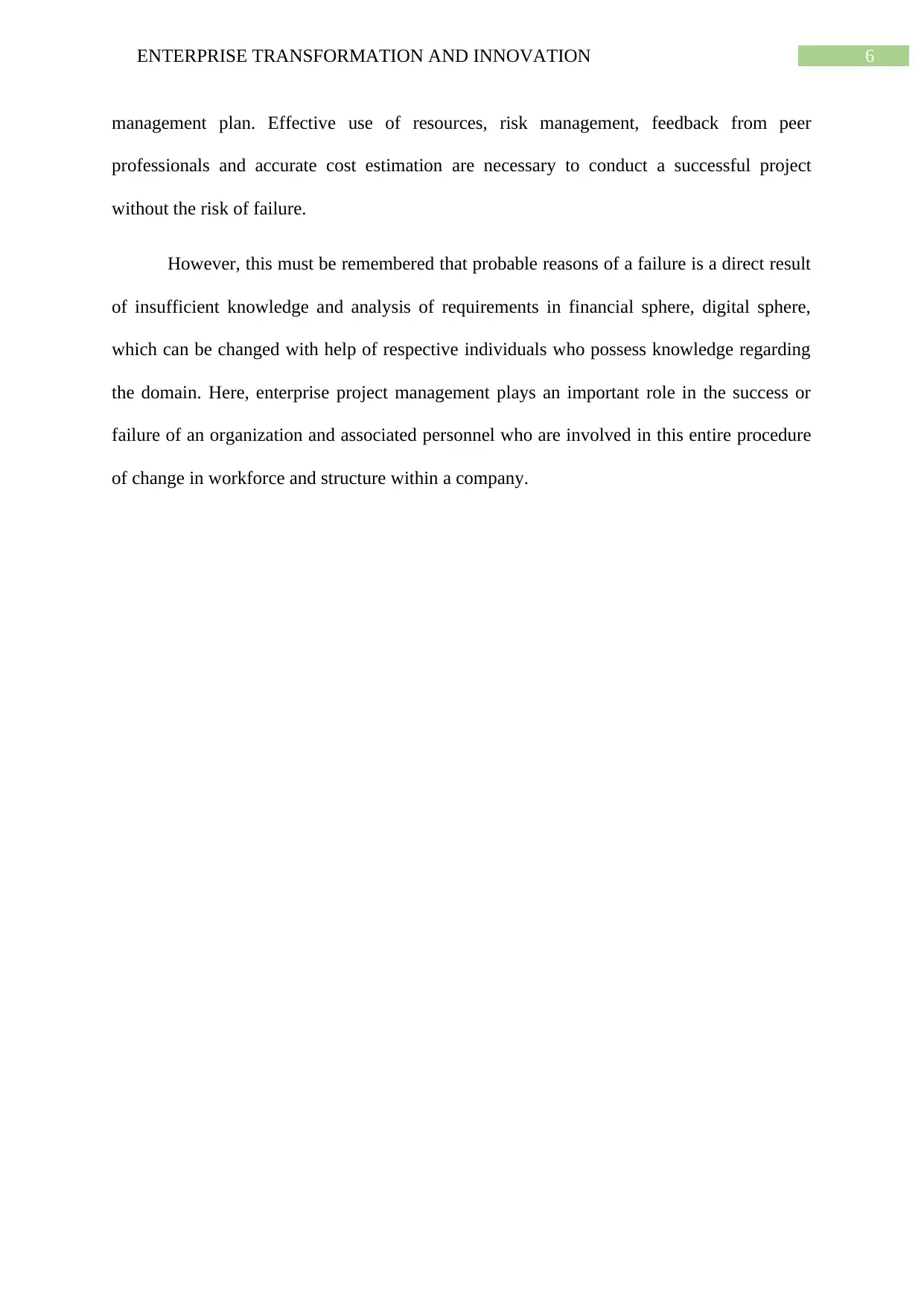
6ENTERPRISE TRANSFORMATION AND INNOVATION
management plan. Effective use of resources, risk management, feedback from peer
professionals and accurate cost estimation are necessary to conduct a successful project
without the risk of failure.
However, this must be remembered that probable reasons of a failure is a direct result
of insufficient knowledge and analysis of requirements in financial sphere, digital sphere,
which can be changed with help of respective individuals who possess knowledge regarding
the domain. Here, enterprise project management plays an important role in the success or
failure of an organization and associated personnel who are involved in this entire procedure
of change in workforce and structure within a company.
management plan. Effective use of resources, risk management, feedback from peer
professionals and accurate cost estimation are necessary to conduct a successful project
without the risk of failure.
However, this must be remembered that probable reasons of a failure is a direct result
of insufficient knowledge and analysis of requirements in financial sphere, digital sphere,
which can be changed with help of respective individuals who possess knowledge regarding
the domain. Here, enterprise project management plays an important role in the success or
failure of an organization and associated personnel who are involved in this entire procedure
of change in workforce and structure within a company.
Paraphrase This Document
Need a fresh take? Get an instant paraphrase of this document with our AI Paraphraser
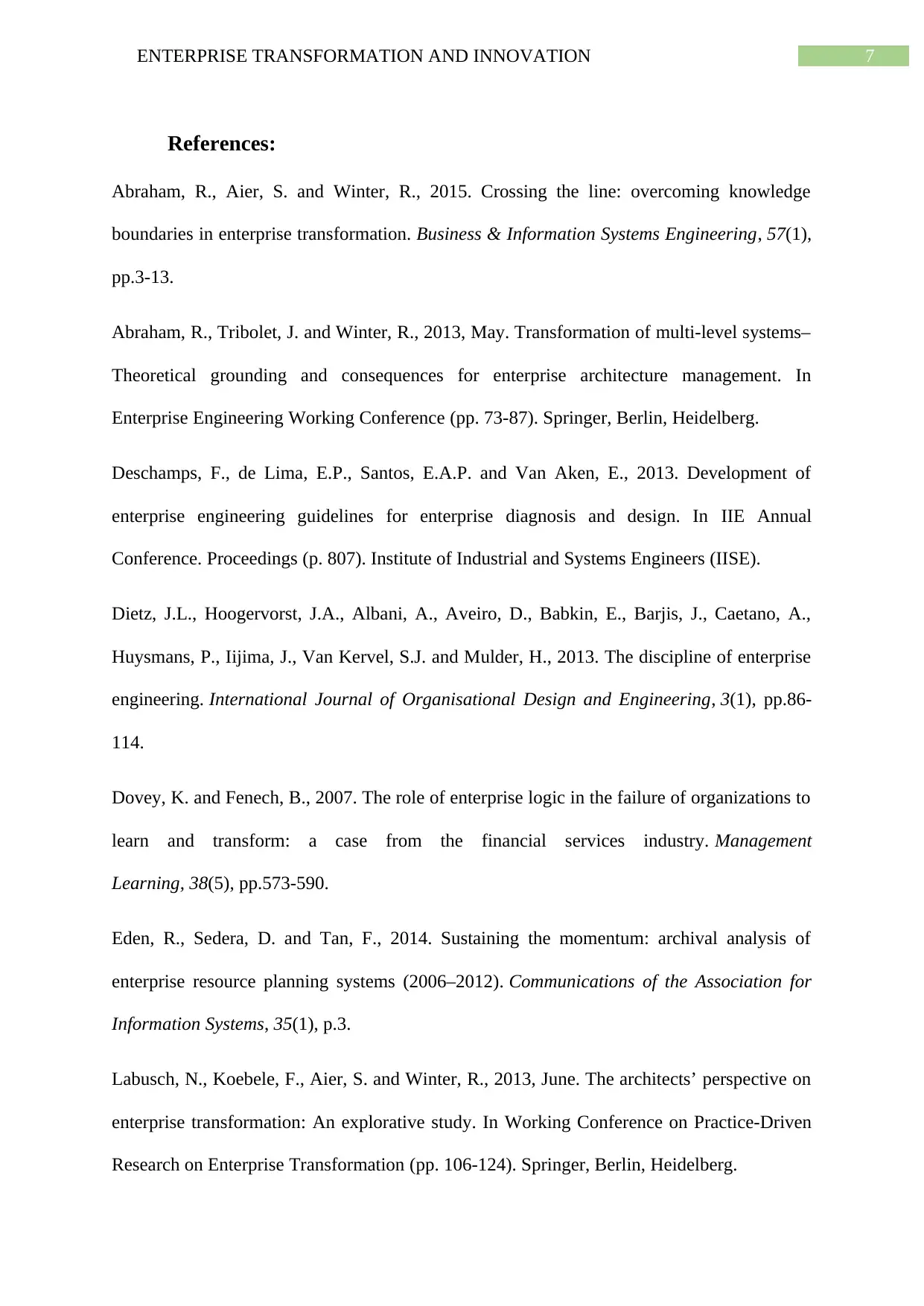
7ENTERPRISE TRANSFORMATION AND INNOVATION
References:
Abraham, R., Aier, S. and Winter, R., 2015. Crossing the line: overcoming knowledge
boundaries in enterprise transformation. Business & Information Systems Engineering, 57(1),
pp.3-13.
Abraham, R., Tribolet, J. and Winter, R., 2013, May. Transformation of multi-level systems–
Theoretical grounding and consequences for enterprise architecture management. In
Enterprise Engineering Working Conference (pp. 73-87). Springer, Berlin, Heidelberg.
Deschamps, F., de Lima, E.P., Santos, E.A.P. and Van Aken, E., 2013. Development of
enterprise engineering guidelines for enterprise diagnosis and design. In IIE Annual
Conference. Proceedings (p. 807). Institute of Industrial and Systems Engineers (IISE).
Dietz, J.L., Hoogervorst, J.A., Albani, A., Aveiro, D., Babkin, E., Barjis, J., Caetano, A.,
Huysmans, P., Iijima, J., Van Kervel, S.J. and Mulder, H., 2013. The discipline of enterprise
engineering. International Journal of Organisational Design and Engineering, 3(1), pp.86-
114.
Dovey, K. and Fenech, B., 2007. The role of enterprise logic in the failure of organizations to
learn and transform: a case from the financial services industry. Management
Learning, 38(5), pp.573-590.
Eden, R., Sedera, D. and Tan, F., 2014. Sustaining the momentum: archival analysis of
enterprise resource planning systems (2006–2012). Communications of the Association for
Information Systems, 35(1), p.3.
Labusch, N., Koebele, F., Aier, S. and Winter, R., 2013, June. The architects’ perspective on
enterprise transformation: An explorative study. In Working Conference on Practice-Driven
Research on Enterprise Transformation (pp. 106-124). Springer, Berlin, Heidelberg.
References:
Abraham, R., Aier, S. and Winter, R., 2015. Crossing the line: overcoming knowledge
boundaries in enterprise transformation. Business & Information Systems Engineering, 57(1),
pp.3-13.
Abraham, R., Tribolet, J. and Winter, R., 2013, May. Transformation of multi-level systems–
Theoretical grounding and consequences for enterprise architecture management. In
Enterprise Engineering Working Conference (pp. 73-87). Springer, Berlin, Heidelberg.
Deschamps, F., de Lima, E.P., Santos, E.A.P. and Van Aken, E., 2013. Development of
enterprise engineering guidelines for enterprise diagnosis and design. In IIE Annual
Conference. Proceedings (p. 807). Institute of Industrial and Systems Engineers (IISE).
Dietz, J.L., Hoogervorst, J.A., Albani, A., Aveiro, D., Babkin, E., Barjis, J., Caetano, A.,
Huysmans, P., Iijima, J., Van Kervel, S.J. and Mulder, H., 2013. The discipline of enterprise
engineering. International Journal of Organisational Design and Engineering, 3(1), pp.86-
114.
Dovey, K. and Fenech, B., 2007. The role of enterprise logic in the failure of organizations to
learn and transform: a case from the financial services industry. Management
Learning, 38(5), pp.573-590.
Eden, R., Sedera, D. and Tan, F., 2014. Sustaining the momentum: archival analysis of
enterprise resource planning systems (2006–2012). Communications of the Association for
Information Systems, 35(1), p.3.
Labusch, N., Koebele, F., Aier, S. and Winter, R., 2013, June. The architects’ perspective on
enterprise transformation: An explorative study. In Working Conference on Practice-Driven
Research on Enterprise Transformation (pp. 106-124). Springer, Berlin, Heidelberg.
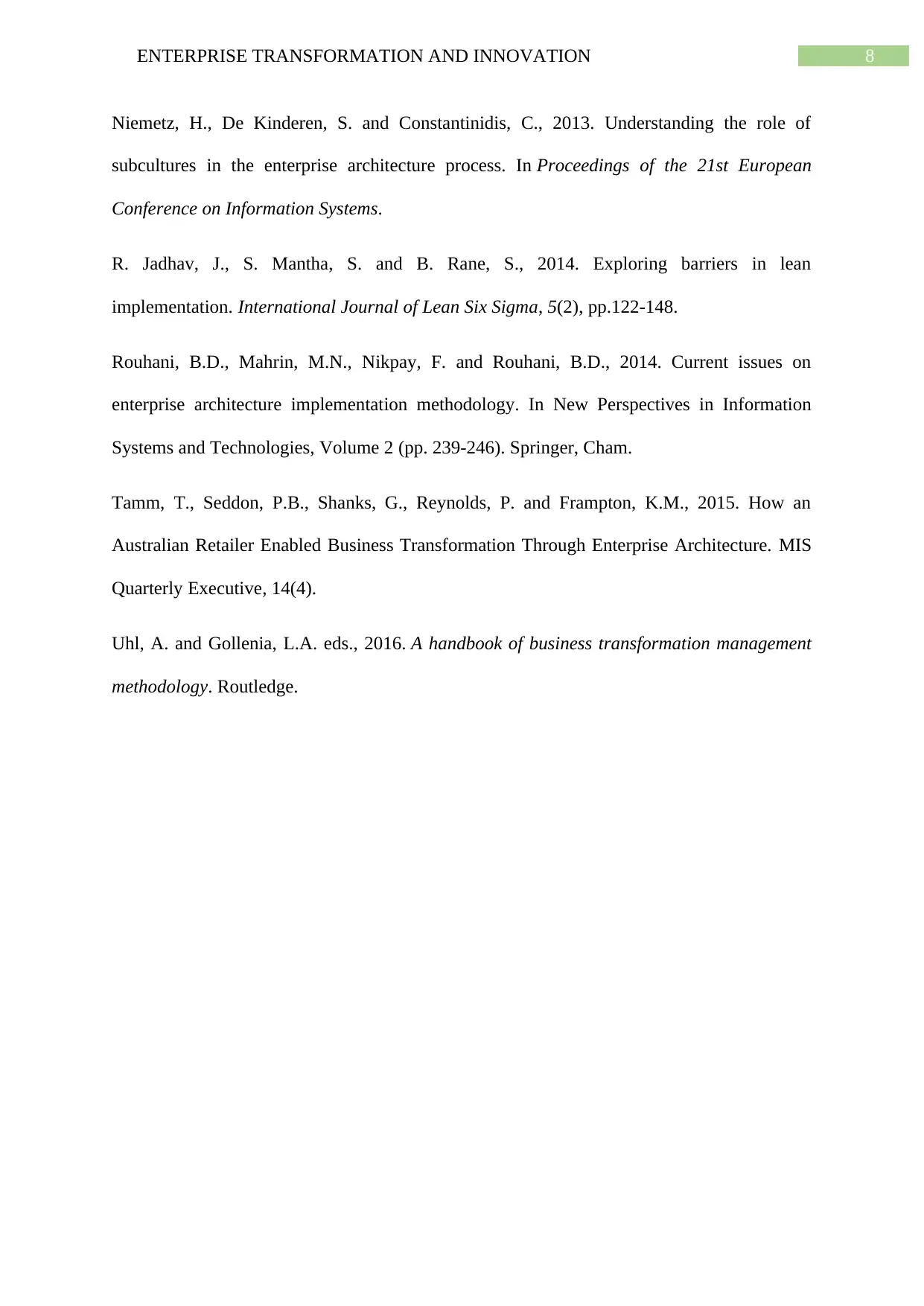
8ENTERPRISE TRANSFORMATION AND INNOVATION
Niemetz, H., De Kinderen, S. and Constantinidis, C., 2013. Understanding the role of
subcultures in the enterprise architecture process. In Proceedings of the 21st European
Conference on Information Systems.
R. Jadhav, J., S. Mantha, S. and B. Rane, S., 2014. Exploring barriers in lean
implementation. International Journal of Lean Six Sigma, 5(2), pp.122-148.
Rouhani, B.D., Mahrin, M.N., Nikpay, F. and Rouhani, B.D., 2014. Current issues on
enterprise architecture implementation methodology. In New Perspectives in Information
Systems and Technologies, Volume 2 (pp. 239-246). Springer, Cham.
Tamm, T., Seddon, P.B., Shanks, G., Reynolds, P. and Frampton, K.M., 2015. How an
Australian Retailer Enabled Business Transformation Through Enterprise Architecture. MIS
Quarterly Executive, 14(4).
Uhl, A. and Gollenia, L.A. eds., 2016. A handbook of business transformation management
methodology. Routledge.
Niemetz, H., De Kinderen, S. and Constantinidis, C., 2013. Understanding the role of
subcultures in the enterprise architecture process. In Proceedings of the 21st European
Conference on Information Systems.
R. Jadhav, J., S. Mantha, S. and B. Rane, S., 2014. Exploring barriers in lean
implementation. International Journal of Lean Six Sigma, 5(2), pp.122-148.
Rouhani, B.D., Mahrin, M.N., Nikpay, F. and Rouhani, B.D., 2014. Current issues on
enterprise architecture implementation methodology. In New Perspectives in Information
Systems and Technologies, Volume 2 (pp. 239-246). Springer, Cham.
Tamm, T., Seddon, P.B., Shanks, G., Reynolds, P. and Frampton, K.M., 2015. How an
Australian Retailer Enabled Business Transformation Through Enterprise Architecture. MIS
Quarterly Executive, 14(4).
Uhl, A. and Gollenia, L.A. eds., 2016. A handbook of business transformation management
methodology. Routledge.
⊘ This is a preview!⊘
Do you want full access?
Subscribe today to unlock all pages.

Trusted by 1+ million students worldwide
1 out of 9
Related Documents
Your All-in-One AI-Powered Toolkit for Academic Success.
+13062052269
info@desklib.com
Available 24*7 on WhatsApp / Email
![[object Object]](/_next/static/media/star-bottom.7253800d.svg)
Unlock your academic potential
Copyright © 2020–2025 A2Z Services. All Rights Reserved. Developed and managed by ZUCOL.





